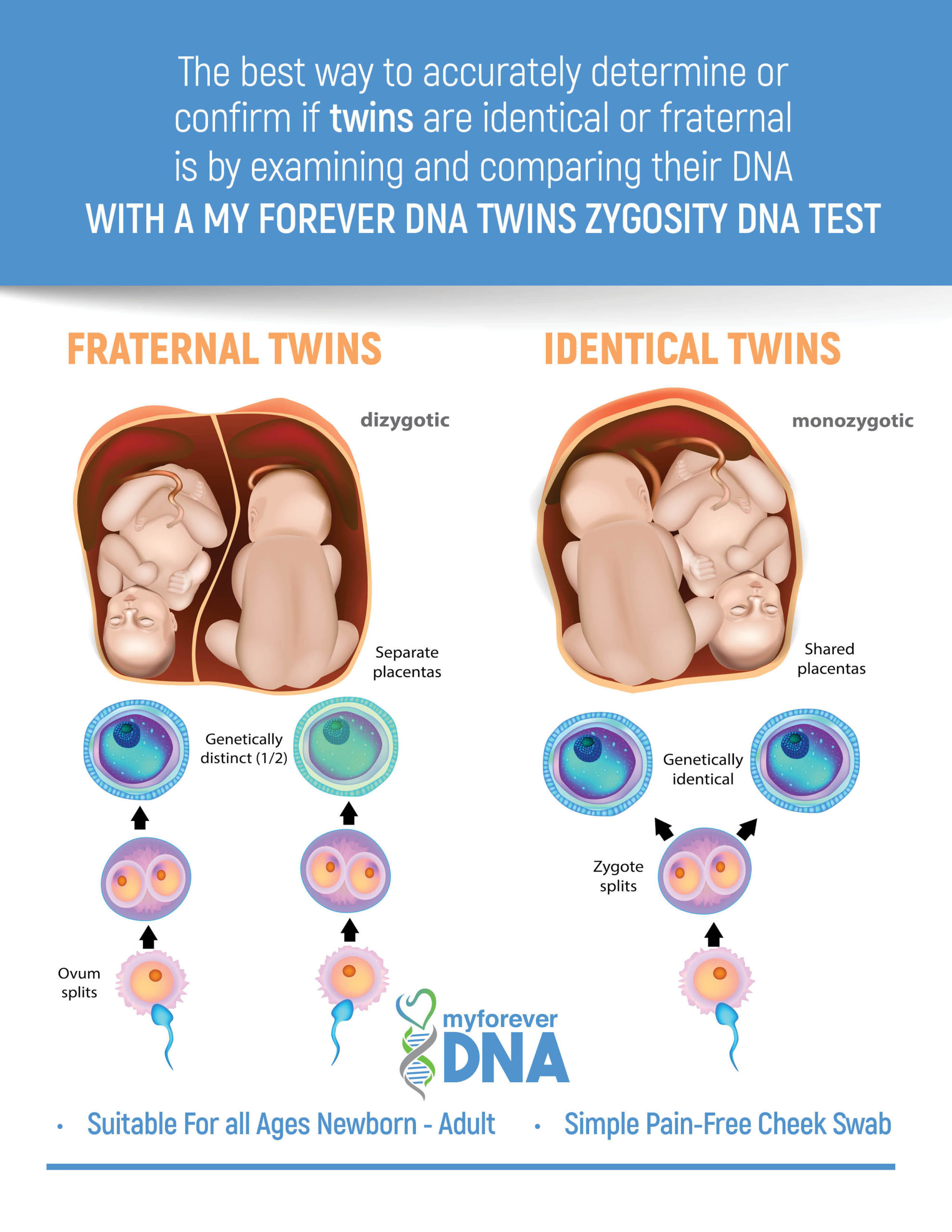Complete Home | TWIN ZYGOSITY | DNA Test Kit
Twin Zygosity DNA testing will determine if twins are identical (also known as paternal twins) or fraternal. Looking at the resemblance and the physical characteristics between twins is not always a clear way of knowing if twins are monozygotic (identical) or dizygotic (fraternal). Identical twins will have the same blood groups; they can donate blood and organs to one another. Are you looking for an at-home twin DNA test or interested in learning more about how to determine who carries the twin gene? Contact us for pricing on the zygosity DNA test. Call Call us at 1-402-800-7161 or email Email us at sales@myforeverdna.com.
Two Options – Reliable Twin Zygosity DNA Tests
1. At-home Twin Zygosity DNA Testing Kit
My Forever DNA makes it easy to discreetly confirm whether or not twins are paternal or fraternal within the comfort and safety of your home. FDA-Approved Sterile cheek swabs, simple step-by-step instructions, prepaid postage, and packaging are sent directly to your door in an unmarked envelope. This and a caring support team make twin zygosity testing easy and confidential.
Our Gold Standard Tests:
- Guarantee Accuracy
- Are 100% Confidential & Discreet
- Include FREE Shipping
- Charge NO lab FEES
- Test 24 DNA (Genetic) Markers
2. Multiple Location DNA Testing Kit
My Forever DNA understands testing twins may be logistically challenging for some reason. This identical and fraternal twin DNA test kit streamlines the DNA collection process and delivers fast, reliable results for those living in two different locations.
Get results in three simple steps.
1. Both individuals are assigned unique identification numbers to ensure DNA sample matching. 2. Two kits are shipped via FedEx (2 Day Shipping) with a tracking number to make the kits easy to monitor every step of the way. Shipping back to our lab is included in the cost. 3. Once all samples have been received, you can expect your accurate results within 1-3 business days.
Our Gold Standard Tests:
- Guarantee Accuracy
- Are 100% Confidential & Discreet
- Include FREE Shipping
- Charge NO lab FEES
- Test 24 DNA (Genetic) Markers
Processing
Our laboratory technicians carefully handle and prepare your DNA samples for processing. Every twin zygosity test with cheek-swab samples is run two separate times by independent teams. Our US-based contracted lab is AABB Accredited, the gold standard in accreditations, and participates annually in College of American Pathologists (CAP) proficiency testing. Every DNA test is verified and signed off on by our Chief Scientific Officer before your results report is prepared. You may receive your confidential results by email, phone, or mail.
No Hidden Fees
This test includes ALL Lab Fees to compare DNA patterns.
Free Shipping
At-Home Twin DNA Test Kits will be shipped FedEx in a discreet, UNMARKED package. A prepaid FedEx envelope to return samples to our lab will also be included. The tracking numbers will be emailed to the address provided, giving you the ability to monitor the samples every step of the way. For international shipping, please call 1-402-800-7161 or email sales@myforeverdna.com.
Fast Results
Results will be emailed within 1-3 business days once all samples have been received at the lab. If discreet or alternative DNA samples are sent in place of a standard cheek swab, results will be emailed within 10-15 business days.
Excellent Customer Service
A Customer Care Specialist will be assigned to you once your samples are received. For questions prior to sending in samples, call 1-402-800-7161 or email sales@myforeverdna.com to speak with our friendly and knowledgeable staff.
We Ship to Multiple Locations
When the need arises to test people who live in different places, coordinating samples can be challenging. Consider simplifying the process with our Multiple Location DNA Test Kit. We’ll ship two kits, match the samples at the lab, and send results within 1-3 business days after all samples are received.
Discreet DNA Testing Using Alternative DNA Samples
At My Forever DNA, we understand some situations require covert DNA testing. For those who want to test an individual without asking for a cheek swab, there are several alternative ways to collect a DNA sample. Discreet testing is possible using samples such as hair, toothbrushes, fingernail clippings, ear wax swabs, cigarette butts, chewing gum, and many others.
View our complete list of acceptable sources for alternative DNA samples.
When purchasing any of our DNA test kits, simply provide a cheek swab or an alternative sample for one or more of the individuals being tested. It is acceptable to send a standard cheek swab for one individual and an alternative sample for another person being tested. Hair DNA tests are common alternatives to cheek swaps.
Once the alternative DNA sample (Ex. toothbrush or hair sample) is received, it will be sent to our forensic lab for viability testing. The testing fee for viability is non-refundable.
If the sample contains enough viable DNA to process, you will be notified by email and the sample will move forward to comparison testing. Your final results will be emailed within 10-15 business days.


















